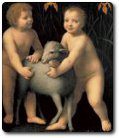Songs of Innocence and Experience Contents
Spring - Synopsis and commentary
Synopsis of Spring
.jpg)
The speaker comments on the merry noises, animals and children that are the herald of – and who welcome – springtime. In the last stanza the speaker asks to caress, and be caressed by, a lamb, as together they welcome spring.
The poem continues the pastoral theme, looking at harmony between nature and human beings. It reads like a child's celebration of spring and new life. Some critics also read it as a poem about sexual awakening, of which the child is unaware. As with most of Blake's evocations of innocence, there is an underlying awareness that less positive dimensions to the situation exist, but are outside the speaker's awareness.
Commentary
‘Boy' and ‘girl' without definite articles, like ‘lark' and ‘nightingale', are universalised figures. They are not particular children or birds but representative of the species. The poem can be read as an expression of the child's joy in recognition of the new, tender life of spring, which is like the little boy's. The ‘Girl' figure suggests affinity with what is sweet and small in burgeoning nature.
However, it can also be suggested that the speaker misses undercurrents in the language s/he is using. The little boy's joy can be associated with the awakening of new life and thus to his awakening sexuality. This suggestion is enhanced by ‘sweet and small': the girl is attractive but passive, the object of admiration.
 The third stanza shows the affinity between child and lamb. The innocence and tenderness of the two are emphasised in the description ‘white neck', ‘soft wool', ‘soft face'. However, child and lamb, being so tender, are also vulnerable. Even at the natural level the lamb will go on to be eaten. The child will be exposed to dangers and threats as he grows. All the resonances of the two images work to remind the reader that gentleness, softness and tenderness render their possessors vulnerable. If we relate this vulnerability to the sexual awakening suggested by stanza two, another dimension appears. The present tender relationship between child and lamb also speaks of the potential for such kinds of relationship to become one of devourer and devoured.
The third stanza shows the affinity between child and lamb. The innocence and tenderness of the two are emphasised in the description ‘white neck', ‘soft wool', ‘soft face'. However, child and lamb, being so tender, are also vulnerable. Even at the natural level the lamb will go on to be eaten. The child will be exposed to dangers and threats as he grows. All the resonances of the two images work to remind the reader that gentleness, softness and tenderness render their possessors vulnerable. If we relate this vulnerability to the sexual awakening suggested by stanza two, another dimension appears. The present tender relationship between child and lamb also speaks of the potential for such kinds of relationship to become one of devourer and devoured.
Investigating Spring
- Make a list of the ways in which Blake identifies children with natural growth and freedom in this poem
Recently Viewed
Related material
Scan and go

Scan on your mobile for direct link.